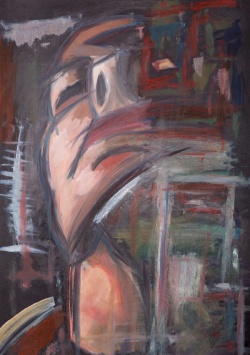Pain is the point of departure for medical interaction
Pain is the point of departure of any medical interaction. When a body sends out pain signals to say that something is wrong, the person in pain will react – either by selfmedication or by consulting a physician.

In the latter case, the person becomes a patient and the physician turns into a detective who tries to detect the source of pain. That’s where misunderstandings in terms of communication and knowledge begin. Where does the patient feel the pain and how does he or she express the pain? Is the physician sufficiently trained and experienced to understand the patient? Which factors, such as gender, age or cultural background, play a role in the communication process? Can a subjective phenomenon such as pain be objectively described?
Little knowlegde about pain
Those are some of the questions all actors in the ‘pain play’ have long tried to answer. The fact is that European medical training does not sufficiently address the issue of pain (see EH 5 2013, p. 2). Physicians are not the only ones needing ‘pain training’, patients also need to understand their situation on the biological, psychological and social level. Thus the physician needs to be a good trainer.
At this year’s German Pain Congress), co-organised by the Deutsche Schmerzgesellschaft e.V., the German section of the International Association for the Study of Pain (IASP) in Hamburg, several sessions focused on this complex issue. The panellists agreed that little is known about pain, since it is difficult to research such a subjective condition. In everyday healthcare work, however, the way to start is for patient and physician to meet on a level playing field, ideally equipped with a tool that can record the characteristics of the pain as objectively as possible. While physicians regularly collect information on basic pain characteristics, such as intensity, duration, minimum, maximum and quality, anything beyond this fundamental information, e.g. instruction, scales, etc., still varies significantly.
Moreover, the interpretation of the pain-related information differs from physician to physician. ‘The patient feels pain in places where the surgeon would not expect pain to occur and even small interventions can cause severe pain,’ explains Professor Esther Pogatzki-Zahn, from the Department of Anaesthesiology, Post-surgical Intensive Medicine and Pain Therapy at the University Hospital Münster. ‘While there are several predictors for pain intensity currently being researched, it may well be that these predictors change with patient age.’
Morphine: still the gold standard
The idea of the ‘pain-free hospital’ took hold in Münster ten years ago aiming to dispense adequate medication. Painkillers, above all opiates, are usually under-dosed for fear of dependency and for financial reasons. Professor Michael Überall, President of Deutsche Schmerzliga e.V. (DSL – German Pain League), presented his experience of treating chronic non-cancer pain with strong opioid analgesics. There is considerable discussion as to whether the pharmacological differences between the opioids that are subject to German regulation are clinically relevant and should thus be the basis of an individualised pharmacotherapy or not.
A large Swedish register study evaluating 50,223 patients with chronic non-cancer pain concluded that patients with non-cancer pain who initiated treatment with CR (controlled-release) morphine had a 19% higher risk of opioid rotation than patients initiated with CR oxycodone (Journal of Pain Research 2013; 6: 379-386). These results correspond to the pharmacological differences between the two opioid agonists oxycodone and morphine as well as to the clinical experience of many pain therapists.
The differences between the currently available opioid analgesics are even more significant when the range of analysed active ingredients is expanded to include available combination products.
Prof. Überall explains that, apart from cancer patients, those who benefit from opioids are, above all, patients with chronic pain, e.g. patients with inflammatory-degenerative joint disease, back pain and neuropathic pain. However, opioid dispensation can be problematic. ‘Patients with chronic pain are already on medication. During hospital admission they receive different drugs with other side effects, or the active ingredients don’t work well together. The patient has little say in his or her medication.’
Financial considerations
As anywhere, these also have a role, the professor points out.‘ Apart from the fact that a pain-free patient can be discharged sooner, consider this figure: in Germany alone we could save €19 billion just by optimising medication. Two thirds of this amount can be saved because patients comply much better when, from the very beginning, they receive the right medication at the right dose.’ Dr Überall emphasises that, in healthcare, the patient, physician and insurer need to continue to focus on three basic ethical principles: do well, don’t do any harm and respect the autonomous individual.
Profile:
In 1990 Professor Michael Überall graduated in medicine at Friedrich Alexander University Erlangen-Nürnberg, Germany, where, in 1996, he became Head of Epilepsy Outpatient Services at the Clinic and Policlinic for Children and Adolescents and later senior resident at the Neuropaediatrics Department.
In 1988 the university hospital’s new social-paediatric centre introduced outpatient services for paediatric headache patients and Dr Überall focused on difficultto- treat epilepsy patients, hydrocephalus patients with cerebral shunts and spina bifida patients.
Following his habilitation in paediatrics, Dr Überall was appointed Medical Director of the Institute for Neurosciences, Pain Management and Paediatrics (IFNAP) in Nuremberg in 2003. In the same year he became Vice President of the German Society of Pain Therapy (DGS).
The professor has headed the Institute for Quality Assurance in Pain Therapy & Palliative Medicine since 2004 (IQUISP). In 2011 he received a special award from the DGS.
He has also been President of the Deutsche Schmerzliga (DSL) since 2012
19.12.2013










